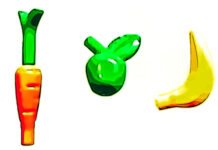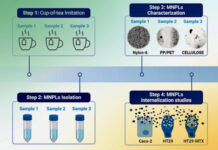An Italian study shows that the presence of microplastics in carotid plaques increases cardiovascular risk, with more events of heart attack, stroke and death. (1)
Microplastics and cardiovascular risk, the study
French researchers they selected 312 people (aged 18-75 years) who underwent carotid endarterectomy, i.e. an operation for the removal of atheromatous plaques (fat and scar tissue) at the terminal bifurcation of the carotid artery.
Patients were recruited from the Cardarelli Hospital and the Ospedale del Mare, both in Naples, and from the University of Salerno from 1 August 2019 to 31 July 2020.
After plaque analysis removed atherosclerotic disease, the researchers divided the patients into two groups, depending on the presence or absence of microplastics.
Always identify two plastics
Analyzes have highlighted the presence of only two microplastics, among the eleven researched: polyethylene and polyvinyl chloride. Both are used in a wide range of applications, including the production of food and cosmetic containers and water pipes.
The presence of microplastics in the human body it is explained by the inhalation and ingestion of the nanometric fragments (1 nanometer is a billionth of a meter) that plastics release, especially in the degradation phase of the material. Contaminants that travel through air, water, food. (2,3,4)
Microplastics they have already been found in the placenta, lungs and blood. (5,6,7) And now it has been shown that they also accumulate in atherosclerotic plaques.
Microplastics in atherosclerotic plaques
Out of 257 patients who – net of deaths, strokes and exclusion due to abandonment of screening – have completed the follow-up:
- 150 patients (58,4%) had a detectable amount of polyethylene in the excised carotid plaque and
- 31 of these (12,1%) also had a measurable amount of polyvinyl chloride in the carotid plaque.
The medium level of plastic (fragments of less than 200 nm) for each mg of plaque was measured to be 21,7 μg for polyethylene and 5,2 μg for polyvinyl chloride.
The results of the follow-up
In the 36 months of follow-up (until 1 July 2023) the patients were followed by doctors with visits and tests. It emerged that in the 257 remaining participants the incidence of non-fatal myocardial infarction, non-fatal stroke and death from any cause was
- 7,5%, i.e. 8 patients out of 107, in the group without the presence of microplastics in the plaque,
- 20%, equal to 30 patients out of 150, in the group with microplastics in the plaque.
The damage of microplastics in the human body
Considering the hypothesis already stated In the literature that microplastics can induce proinflammatory processes, researchers also measured four inflammatory markers in patients (interleukin-18, interleukin-1β, interleukin-6 and TNF-α). The analysis confirmed the correlation.
Preclinical studies they also predicted what emerges from the Italian study.
‘Polyethylene nanoplastics have been reported to induce a variety of detrimental effects on the cardiovascular system in zebrafish embryos, promoting the development of pericardial effusions, inhibition of angiogenesis, and induction of a prothrombotic state. Similar data is available from studies on the effects of polyvinyl chloride. However, in most preclinical studies, elevated levels of MNP are assessed, orders of magnitude higher than those observed in the present study, a factor that makes it difficult to extrapolate the relevance of preclinical findings to humans.’, explain the authors of the study.
Marta Strinati
Footnotes
(1) Raffaele Marfella, MD, Ph.D., Francesco Prattichizzo, Ph.D., Celestino Sardu, MD, Ph.D., Gianluca Fulgenzi, Ph.D., Laura Graciotti, Ph.D., Tatiana Spadoni, Ph.D., Nunzia D’Onofrio, Ph.D., Lucia Scisciola, Ph.D., Rosalba La Grotta, Ph.D., Chiara Frigé, M.Sc., Valeria Pellegrini, M.Sc., Maurizio Municinò , MD Microplastics and Nanoplastics in Atheromas and Cardiovascular Events. N Engl J Med 2024; 390:900-910. March 7, 2024. DOI: 10.1056/NEJMoa2309822
(2) Dario Dongo. Microplastics gone with the wind, contaminated even the air. GIFT (Great Italian Food Trade).
(3) Marta Singed. A new analysis reveals the enormous amount of nanoplastics in bottled water. GIFT (Great Italian Food Trade).
(4) Marta Strinati. Microplastics in fruit and vegetables. The Italian study. GIFT (Great Italian Food Trade).
(5) Marta Strinati, Dario Dongo. Microplastics in our lungs too. The British study. GIFT (Great Italian Food Trade).
(6) Marta Strinati. Microplastics in the blood, first evidence in humans. GIFT (Great Italian Food Trade).
(7) Marta Strinati. Microplastics in the human placenta. The discovery of Italian researchers. GIFT (Great Italian Food Trade).
Professional journalist since January 1995, he has worked for newspapers (Il Messaggero, Paese Sera, La Stampa) and periodicals (NumeroUno, Il Salvagente). She is the author of journalistic surveys on food, she has published the book "Reading labels to know what we eat".








